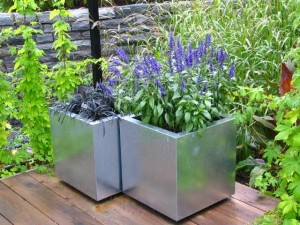





Even in the smallest gardens, with only a patio, it is possible to grow many different plants by confining them in containers. This cramps the root system and prevents them getting too big, and tends to bring the plants into flower earlier. However, plants in containers are prone to drop their leaves or even die unless extremely good care is taken to stop them drying out. This may mean watering three or four times a day in summer. Similarly, attention is needed to prevent the roots freezing in winter. One advantage of growing in containers is that the whole pot can be taken under cover to prevent frost or bird damage, or to bring on earlier growth.
 If you must grow in containers, use the biggest you can manage – plastic dustbins can be converted with holes in the base and are much cheaper than pots. Plants in containers cannot get enough nutrients from ordinary garden soil and need an enriched medium. For most plants, choose a John Innes No 3 potting compost which is based on soil. It is heavy, so helps keep top-heavy plants upright in plastic pots. Peat and peat-alternative composts are as good from most points of view, but potted plants are unstable and hard to re-wet if they do get dry. These composts are usually based on chemical fertilisers, but organically formulated versions are available.
If you must grow in containers, use the biggest you can manage – plastic dustbins can be converted with holes in the base and are much cheaper than pots. Plants in containers cannot get enough nutrients from ordinary garden soil and need an enriched medium. For most plants, choose a John Innes No 3 potting compost which is based on soil. It is heavy, so helps keep top-heavy plants upright in plastic pots. Peat and peat-alternative composts are as good from most points of view, but potted plants are unstable and hard to re-wet if they do get dry. These composts are usually based on chemical fertilisers, but organically formulated versions are available.
To be more organic and for economy, I use sieved garden compost for the bulk of my potting. I adjust it for strength and openness with sharp sand or mole-hill soil, but otherwise it is used as it comes to fill the bottom three-quarters of each pot. Each container is topped off with a sterile mixture of sharp sand and peat, or similar, so I do not suffer a plague of weeds. This works excellently for me, but I recommend it only if you can make good compost!
If you can, choose a dwarfing rootstock and arrange some form of automatic watering system. Wherever possible, try not to use very small pots, baskets or organic growing bags. These may be attractive or temporarily convenient, but they are not kind to plants. Plants have amazingly extensive root systems stretching for yards all round them, and to confine them in small amounts of soil or compost makes their life very difficult. Narrow borders in greenhouses or against walls are much the same, though they usually give a cooler root run than a pot. Any very restricted root run provides too little fertility and risks the soil or compost drying out or waterlogging. Thus any plant may be checked, and it will never do as well as it would in open ground.
Watering really is the biggest problem with plants in containers. Either constant attention or an automatic system is needed. Sprinklers activated by a timer or sensor, drip feeds and capillary matting can be used in a greenhouse, but become more difficult when the containers are spread about a patio, for instance.
Automatic watering is almost essential where large numbers of pots or containers are maintained, such as around patios and in greenhouses. In pots and containers keeping the soil or potting compost moist but not waterlogged is difficult, particularly with the new peat-substitute composts. It is essential to check all pots regularly to see if they need watering. Do this by pushing your thumb into the compost to check how moist it is.
In winter, err on the side of caution. Water rarely but thoroughly and let the pots drain well. Overwatering is a serious risk at this time of year, so good drainage is essential. In summer, water frequently but still drain well. Standing the pots on gravel trays improves drainage and creates a beneficial humid atmosphere around the plants. The gravel soon gets dirty, though, and may harbour disease, so I just use and empty drip trays instead.
All plants growing in containers or small borders soon use up the goodness in the rootball and require supplementary feeding. Liquid feeds can be added to the water at regular intervals, but it must be a very dilute solution so as not to burn delicate roots. Never feed when growth is slow or when the plant is under stress. Foliar feeding with seaweed sprays at monthly intervals will greatly aid all plants in containers.
You can save a lot of effort by choosing plants that will stand water stress well. Pelargoniums, aspidistras, spider plants, succulents and cacti are all good examples. For outdoor containers all year round grow the tougher herbs such as thymes, mints and marjorams — and best of all house leeks, which require less maintenance than plastic flowers. Unless you wish to check their growth, always pot up plants regularly as they fill their container. For permanent pot plants, this means repotting every spring.
Where several plants are in the same pot, use fewer and they will all do better. This applies to growing bags, too. For example, three tomato plants in an organic growing bag do no better than two, and one would produce as much fruit as all three.
Copyright © www.100flowers.win Botanic Garden All Rights Reserved